Looking for a budget-friendly robot vacuum cleaner? The Xiaomi Mi Robot Vacuum Mop 1C is an excellent choice, especially for hard floors. While its mopping function is a bit of a gimmick, it still has exceptional mapping and zoned cleaning capabilities.
The Xiaomi Mi Robot Vacuum Mop 1C was my first foray into the world of automated household helpers. After more than a year of using this little white machine, I recently upgraded to the more advanced ILIFE A11. As such, I feel it's time to provide a thorough review of the Mi Robot Vacuum Mop 1C to help you make an informed purchasing decision.
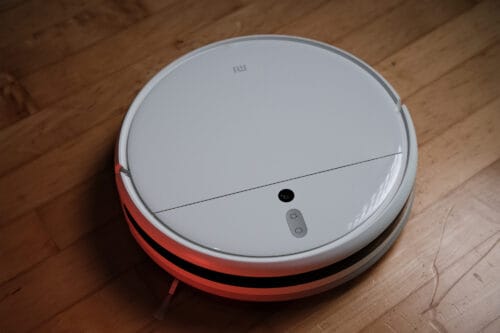
In line with my standard review process, I do not believe in assigning numeric ratings to any device. What significance does it hold if I rate this robot vacuum cleaner at 7.5/10 and another at 8.5/10? What may be important to me may not hold the same importance to you. While I aim to be concise, this review will be comprehensive and long-term.
I want to clarify that this review is written entirely independent of Xiaomi. I did not receive the Mi Robot Vacuum Mop 1C from Xiaomi or any retailer. The contents of this review will not be accessible to anyone before publication, and I am under no obligation or incentive to provide a positive or negative review.
Verdict of the Xiaomi Mi Robot Vacuum Mop 1C
The Xiaomi Mi Robot Vacuum Mop 1C is a great choice for those on a budget, delivering exceptional results on hard floors and acceptable results on carpets. Despite its name, the mopping function is more of a gimmick than a useful feature, only moistening floors and lacking the ability to remove dried stains.
- Mapping: Supports both mapping, path planning, zone cleaning, and spot, cleaning.
- Movement: A barrier-cross height of 20 mm and the option to set virtual walls in the app.
- Cleaning area: With its 2400 mAh battery it can clean an area of 120 ㎡. The rated power of the motor is 40 W.
- Mopping: A 200 ml water tank can be attached to the unit.
- Vacuum cleaning: The suction power reaches 2500 Pa and the dust box has a capacity of 600 ml. The air is filtered through a HEPA filter
- Noise level: 72 dB, which is comparable to a noisy restaurant.
- Dimensions and weight: 35 cm wide, 8.2 cm high, and wheighs 3.6 kg.
Despite its low price, the Xiaomi Mi Robot Vacuum Mop 1C boasts exceptional mapping and zoned cleaning capabilities. However, it is worth noting that it doesn't support multiple floors, and there are no indications that it will eventually. Although Xiaomi offers a cheaper model, the Xiaomi Mi Robot Vacuum-Mop Essential, I highly recommend opting for the Mi Robot Vacuum Mop 1C if your budget allows it.
The good
The bad
The ugly
About this Xiaomi Mi Robot Vacuum Mop 1C review
This review of the Xiaomi Mi Robot Vacuum Mop 1C is based on my experience using it for over a year, running it almost daily before recently replacing it. My home features hard wood or slate floors, with carpets in the living room and entrance hallway, where I used the robot vacuum cleaner. Additionally, I have a cat that sheds in the spring and two young children.
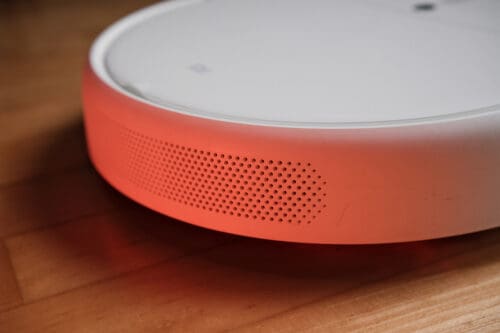
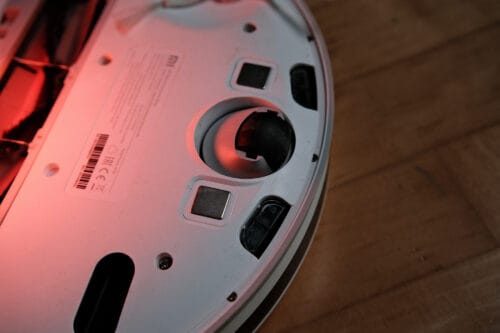
It's important to keep in mind that the Mi Robot Vacuum Mop 1C is a budget-friendly option when considering robot vacuum cleaners. While it may not have advanced features such as LiDAR navigation or better mopping capabilities, it's unfair to criticize it for that at this price point. Even older models, like the Roborock S5 Max (late 2019), still cost around US$100 more. Thus, in this review, I will evaluate the Mi Robot Vacuum Mop 1C as a ~US$200 machine, and you may even be able to find it at a lower price point. As of now, the Swiss Xiaomi store offers it on sale for US$175, which includes taxes, as the listed price reflects what you will pay.
First impressions of the Xiaomi Mi Robot Vacuum Mop 1C
Since the Xiaomi Mi Robot Vacuum Mop 1C is a budget-friendly robot vacuum cleaner, it doesn't come with many additional accessories. In fact, you only receive the vacuum itself and the necessary parts to operate it, which includes:
- A spacious dustbin with a total capacity of 600 ml.
- A side brush that helps push dirt and dust towards the centre of the vacuum's body.
- The main brush, which does the actual cleaning and enables the robot vacuum cleaner to suction up any debris in its path.
- A 200 ml water tank and a microfiber brush for mopping.
- A small tool to aid in cleaning the main brush and dust box.

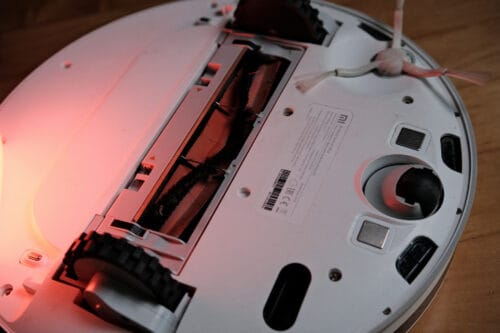
The Mi Robot Vacuum Mop 1C doesn't come with any spare parts or accessories. One thing that's immediately noticeable upon unboxing the device is its sleek and flat design. This is due to its lack of a commonly used LiDAR array that typically sits on top of other robot vacuum cleaners. While some may prioritize better navigation, the Mi Robot Vacuum Mop 1C's height allows it to clean in areas that other models may not be able to reach.
Additionally, it's worth noting that the filter that comes with the vacuum cleaner out of the box does not include a prefilter. This means that the HEPA filter doesn't have a mesh filter covering it, which can lead to it becoming clogged with dirt quickly. However, Xiaomi has since revised this issue, and the replacement filters now come with a mesh filter. As expected, these last much longer.
First clean with the Xiaomi Mi Robot Vacuum Mop 1C
As with any new robot vacuum cleaner, I ran the Mi Robot Vacuum Mop 1C initially with as few obstacles in its path as possible. This assists in creating a precise map of the floor during its first cleaning cycle, which the Mi Robot Vacuum Mop 1C was able to accomplish without any missed spots, despite not having a LiDAR sensor. However, the manner in which it builds this map may be a concern for some.
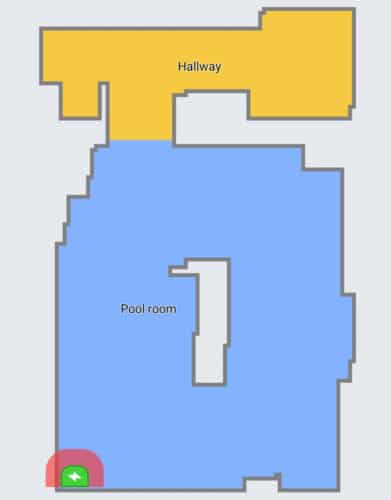
The Xiaomi Mi Robot Vacuum Mop 1C's camera
Despite the exceptional performance of the Mi Robot Vacuum Mop 1C, it may not be the ideal choice for those who highly value privacy. The black dot located below the only two buttons on the vacuum's body is, in fact, a camera. This camera captures images of the features it detects to aid in location tracking. However, if someone is standing next to it, the camera will also record them. I'm not suggesting that Xiaomi misuses these images, but it's essential to be aware of this feature when making a purchasing decision.
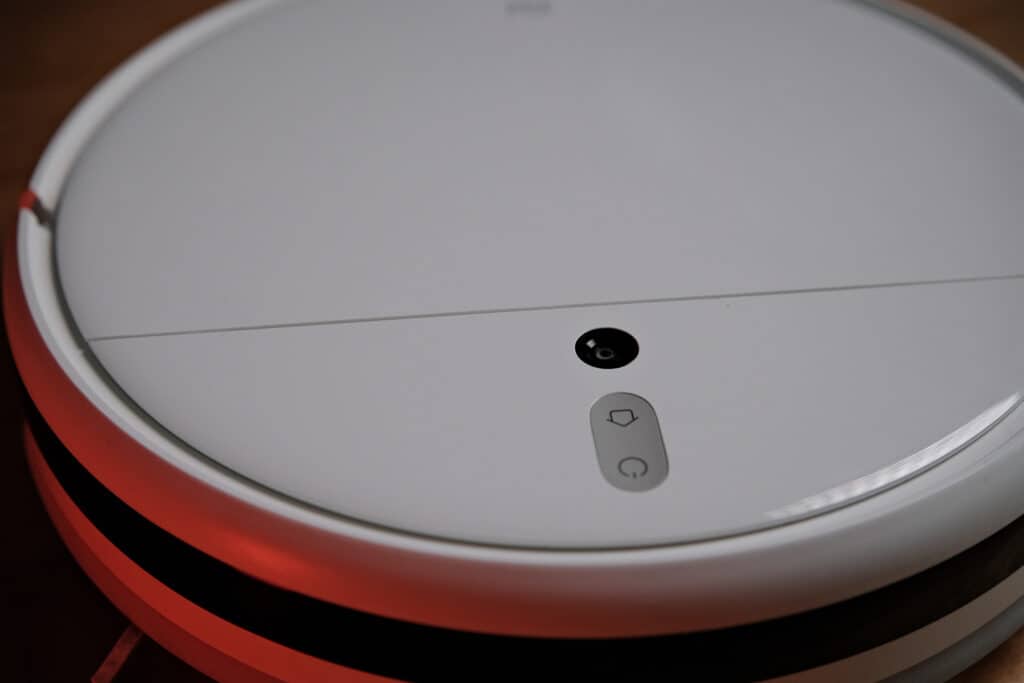
Another disadvantage of using a camera for navigation is that it cannot function in the dark. Similar to any camera, the Mi Robot Vacuum Mop 1C struggles in low-light situations. Although it will still clean the floors, it will not operate as effectively since it lacks the ability to “see” in the dark. In contrast, LiDAR technology does not face this issue. It actively emits an invisible laser across the room and measures the time it takes for it to return, making it visible to the receiving end in complete darkness or full brightness.
How the Xiaomi Mi Robot Vacuum Mop 1C navigates and its performance
The Mi Robot Vacuum Mop 1C possesses more than just a camera for navigation. It also features cliff sensors at the bottom to prevent it from falling down staircases. Additionally, there's an array of IR sensors concealed behind a visor (which I like to call the “Geordi La Forge visor”) that functions similarly to how a smartphone detects whether it's against your face or in your pocket. The Mi Robot Vacuum Mop 1C uses these sensors to identify walls and other large objects. Finally, there's the bumper that covers half of the robot vacuum cleaner's body, which gets activated when it collides with an object.
While this sensor setup may appear impressive, it's not without flaws in real-world usage. The IR sensors can only detect larger objects such as walls and sofas, allowing it to slow down before contacting them. However, it cannot detect smaller objects like the legs of tables and chairs, or most toys, which are often moved about since they aren't heavy enough to activate the bumper. Furthermore, objects that are just high enough to avoid the bumper may trap the robot vacuum cleaner, making it impossible for it to escape. For instance, in my case, the toilet bowl height is perfect for catching the Mi Robot Vacuum Mop 1C, and I have had to rescue it several times from being stuck under the porcelain bowl.
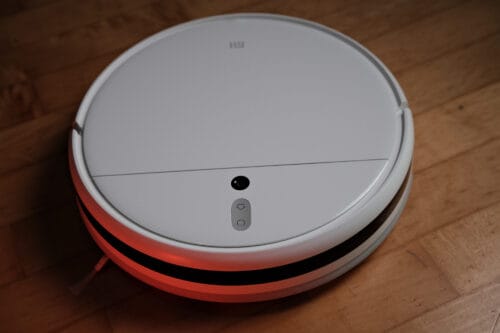
If you live in a household with numerous small objects on the floor and prefer not to remove them before vacuuming, the Xiaomi Mi Robot Vacuum Mop 1C may not be suitable for you. In that scenario, an AI-powered object-avoidance camera placed at the front of the device may be a better option. However, such models, like the Roborock S7 MaxV and iRobot Roomba j7+, are considerably pricier.
Cleaning performance of the Xiaomi Mi Robot Vacuum Mop 1C
If numerical specifications matter to you, then the 2500 Pa suction power of the Xiaomi Mi Robot Vacuum Mop 1C will be significant. This allows us to compare it with other robot vacuum cleaners in the same price range, such as:
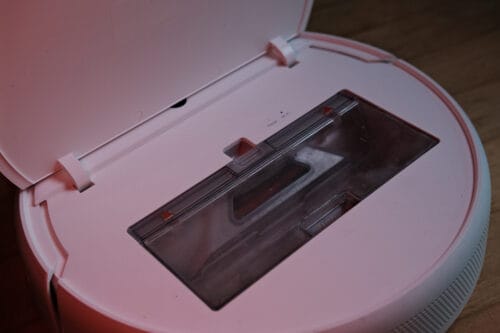
- The Roborock E4, which is similarly priced, has a maximum suction power of 2000 Pa. The pricier Roborock E5 has the same suction power as the Mi Robot Vacuum Mop 1C.
- The eufy by Anker Robovac G10 Hybrid, which costs more than Xiaomi's offering in my country, has significantly less suction power, maxing out at 2000 Pa.
- The Wyze Robot Vacuum, which is much pricier, can produce 2100 Pa of suction.
It's these comparisons that lead me to recommend the Xiaomi Mi Robot Vacuum Mop 1C. In my opinion, it fulfils what a vacuum cleaner should do effectively, thanks to its high suction power. While it may lack the LiDAR sensor that others have, I'm satisfied that Xiaomi chose not to skimp on the actual performance when it comes to vacuuming.
How good of a vacuum cleaner is the Xiaomi Mi Robot Vacuum Mop 1C?
It's difficult to find a robot vacuum cleaner in this price range that offers an impressive 2500 Pa of suction power, which is why the Xiaomi Mi Robot Vacuum Mop 1C is a standout option when it comes to vacuum cleaning. To test its abilities, I created a mixture of rice, flour, coarse brown sugar, and broken up noodles, and had the robot vacuum cleaner attempt to clean it on the highest suction level.
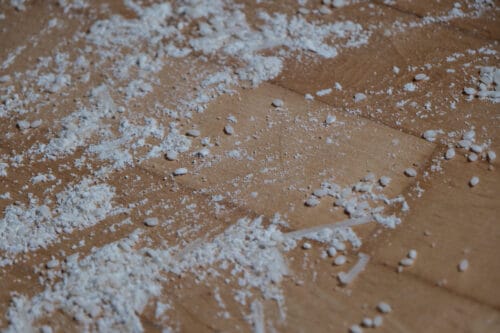



As the “after” photos reveal, the Xiaomi Mi Robot Vacuum Mop 1C struggled to pick up the flour, and the rice wasn't entirely gone either. I believe that the two issues are caused by differing factors: the suction isn't strong enough to pick up the fine flour, and the side brush tends to fling the rice when it moves past it. However, the remaining rice was picked up on the second run, but even two attempts weren't enough to remove all the flour.



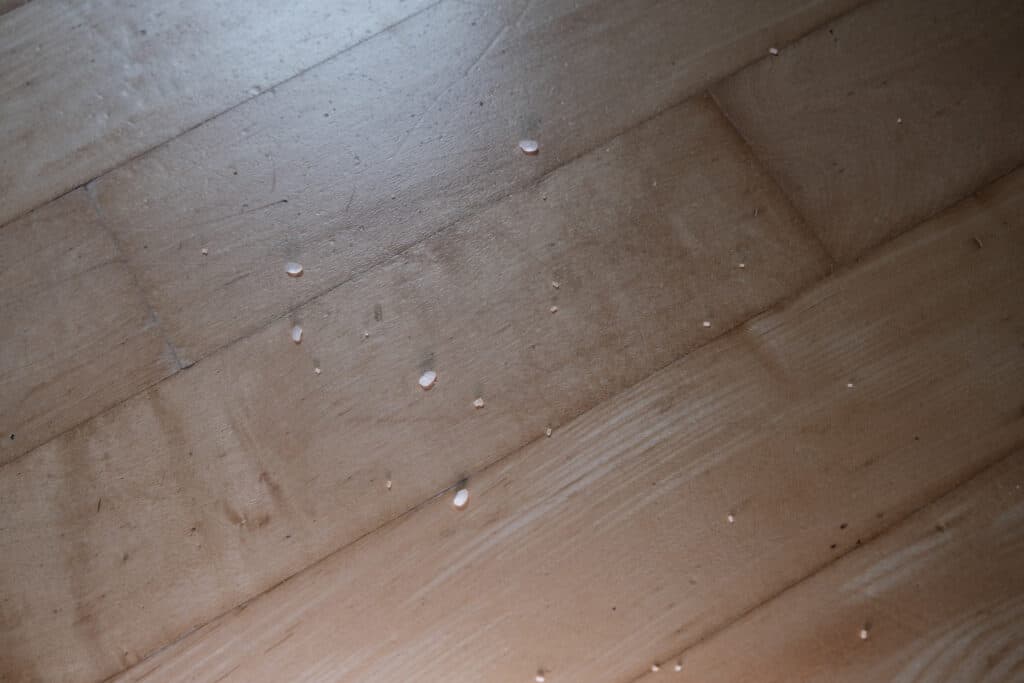
As expected, the Xiaomi Mi Robot Vacuum Mop 1C didn't perform as well on carpets as it did on hard wood floors. While it could collect larger debris such as crisps and other leftovers, it lacked the suction power to remove smaller debris like shedding cat hair.
It mops by dragging a damp rag across the floor
I don't recommend buying the Xiaomi Mi Robot Vacuum Mop 1C for its mopping capabilities. To be honest, no robot vacuum cleaner besides the premium Roborock S7 should be purchased for that reason. While slightly more expensive models do support S and Y mopping, the Xiaomi Mi Robot Vacuum Mop 1C does nothing more than drag a wet microfibre cloth behind it. It might remove some superficial stains, but it won't be able to clean up the dried tomato sauce that your toddlers spread around the dining room table.
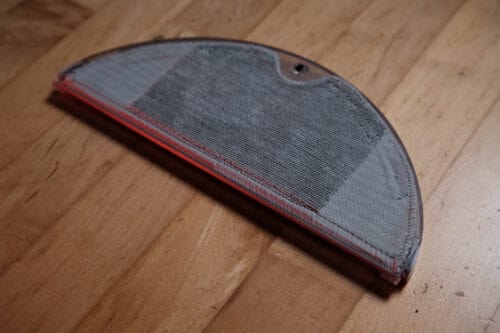

The mop attaches straight to the water tank, which slots in to the underside of the Xiaomi Mi Robot Vacuum Mop 1C. In the app, you can select how damp you want the mop to be, so there is some interaction between the robot vacuum cleaner and the mopping unit. However, you can't disable mopping, and the app also won't inform you if the tank is empty.
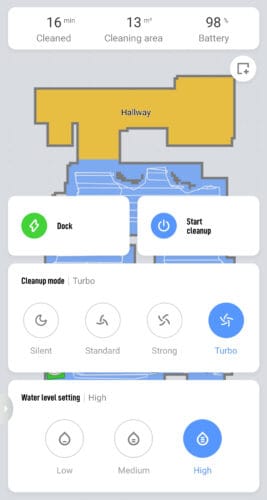
As a reviewer, I felt obligated to test this feature. I simulated a scenario where someone had spilled coffee, tomato sauce, and chocolate cake on a hard wood floor. To make matters worse, they also stepped on the cake, ensuring it stuck and couldn't be cleaned up with a broom.
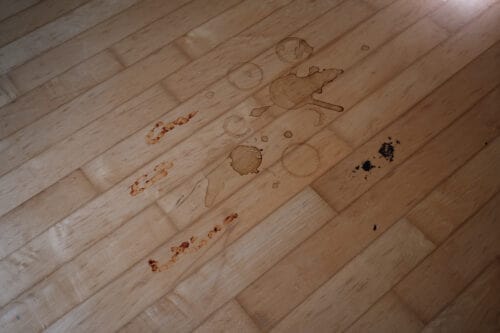
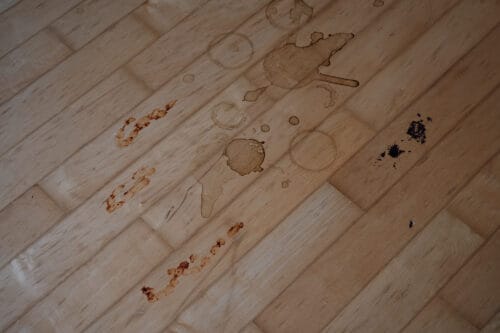
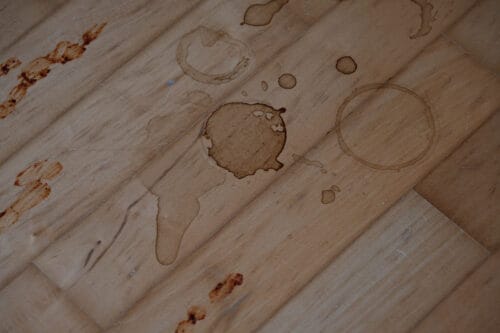
At first glance, the results looked promising, but it took two runs with the mop to achieve them. The Xiaomi Mi Robot Vacuum Mop 1C was able to remove the coffee successfully, but unsurprisingly struggled with the tomato sauce and chocolate cake. It wasn't easy to capture, but I also noticed that it wasn't able to suck up the chocolate cake it had removed. This left the area covered in crumbs that the robot vacuum cleaner spread around.
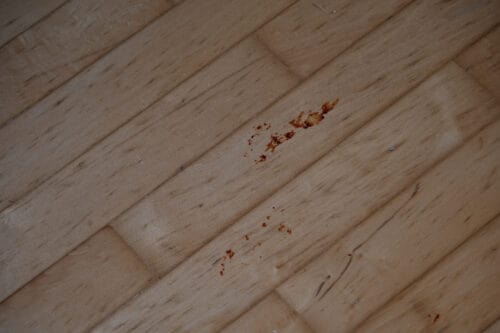
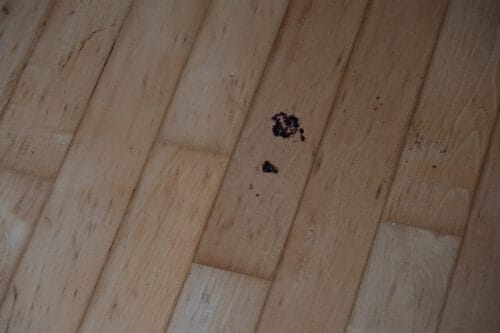
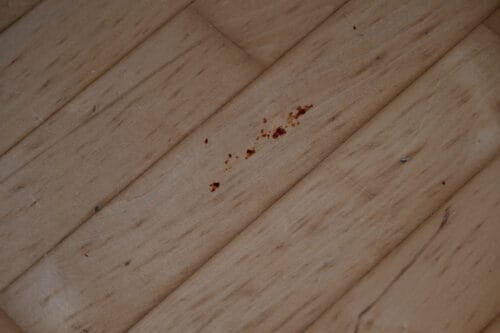
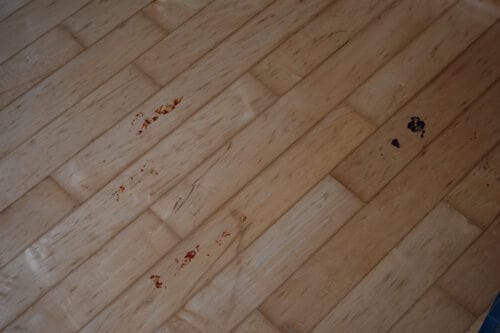
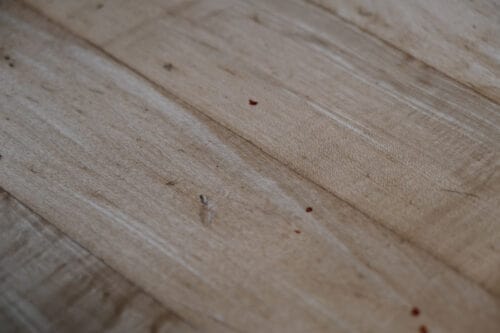
When mopping, you should be aware that the Xiaomi Mi Robot Vacuum Mop 1C doesn't automatically detect carpets. This does not only mean that it won't increase the suction on carpets, but that it will mop everything. For that reason, I do not recommend leaving the mop attached by default, and only attaching it whenever you want to use it. On the plus side, the microfibre cloth is easily removable and can be machine-washed.
The Xiaomi Mi Robot Vacuum Mop 1C could do with a bigger battery
The Xiaomi Mi Robot Vacuum Mop 1C's battery capacity is only 2400 mAh, which is considered small by today's standards. Comparing it to other robot vacuum cleaners at a similar price point, such as the Roborock E4 Robot Vacuum cleaner, which packs a 5200 mAh battery, or the Anker Robovac G10 Hybrid with a 2600 mAh battery pack that can even be replaced, doesn't make the Xiaomi Mi Robot Vacuum Mop 1C look any better. The WYZE Robot Vacuum, which is much pricier, features a 3200 mAh lithium-ion battery.
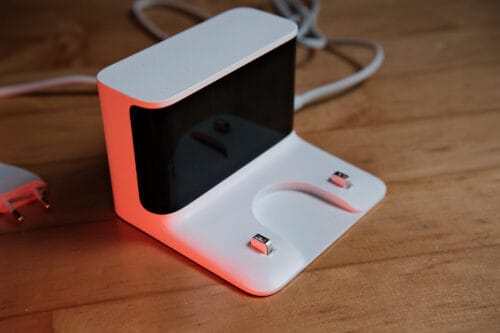
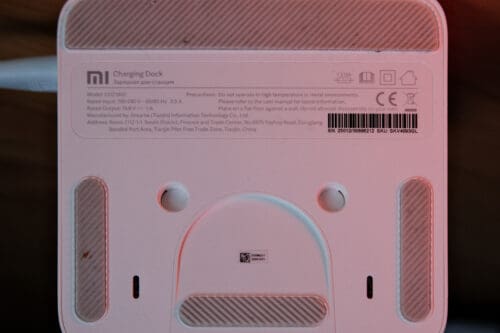
Fortunately, the Xiaomi Mi Robot Vacuum Mop 1C is designed to return to the dock once the battery is below 15%, where it will recharge to 80% and finish the routine. Despite charging at only 20 W, it doesn't take too long to charge because of its small battery capacity. However, I have encountered issues with the vacuum cleaner not docking correctly, as the pogo pins on the dock are on the smaller side and require the Xiaomi Mi Robot Vacuum Mop 1C to line up perfectly. There have been situations where the robot vacuum cleaner would seemingly dock but not charge.
One issue with the dock is the lack of a feature many other manufacturers include – a place to hide excess cable. I believe Xiaomi could have included this feature without increasing the price of this robot vacuum cleaner.
The Xiaomi Home app is chock-full with features
The Xiaomi Mi Robot Vacuum Mop 1C app, Xiaomi Home, is one aspect that I cannot criticize. Xiaomi Home is not exclusively for robot vacuum cleaners, but also for various smart home appliances like air purifiers. The app operates without any glitching or freezing, and its performance is smooth. I operate the Mi Robot Vacuum Mop 1C app on my OnePlus 6 Android smartphone, which is a higher mid-range phone comparable to current models.
Before demonstrating the app using screenshots, it's worth mentioning that I relocated the Mi Robot Vacuum Mop 1C to my cellar. Although it previously cleaned the main floor of the house, it now waits for my lab to be cleaned, but currently, it is too cluttered to allow the robot vacuum cleaner in.
Layout and user interaction of the Xiaomi Home app
The layout and interaction with the Xiaomi Home app is close to perfection. Once you select the Mi Robot Vacuum Mop 1C, you are presented with a map where you can easily select rooms by tapping on any of their areas, or start a full cleaning session with just one button. Swiping up from the bottom of the screen reveals options to adjust the suction and water flow. Within the settings, you can schedule cleaning sessions for the robot vacuum cleaner to follow, and keep track of consumables.
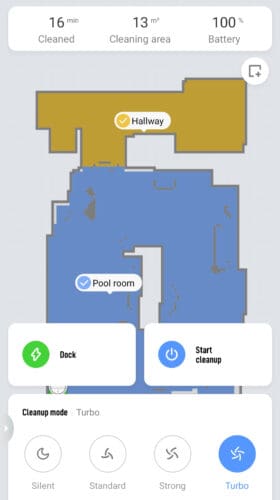


The mapping options are especially interesting. However, keep in mind that using maps requires uploading data to Xiaomi's servers, and your Wi-Fi will also reveal your location. So, be sure to make an informed decision before enabling this feature. You have the option to divide, merge, and name rooms, as well as set up virtual walls and restricted areas.
Limitations of the Xiaomi Home app and Mi Robot Vacuum Mop 1C
To make the Xiaomi Mi Robot Vacuum Mop 1C even more appealing, it would have been nice if it could map multiple floors. Unfortunately, this feature is not available, and I suspect that it's a deliberate decision by Xiaomi rather than a hardware limitation, as other robot vacuum cleaners with similar hardware can store multiple maps. Nevertheless, the Xiaomi Mi Robot Vacuum Mop 1C can still clean areas that haven't been mapped. However, without a pre-existing map, it operates in a less efficient manner, essentially acting like a standard robot vacuum cleaner and mapping the area as it goes.
Useful and unintrusive notifications
Another aspect I appreciate about having the Xiaomi Home app on my phone is that it sends me notifications whenever the vacuum gets stuck somewhere. Although the Xiaomi Mi Robot Vacuum Mop 1C does also “speak”, I won't be able to hear it when it's running in the cellar.
Integrating the Xiaomi Mi Robot Vacuum Mop 1C with your smart home
Integrating smart devices with virtual assistants and home automation platforms has become a common practice in today's connected homes. As such, it's important to know what kind of integrations the Xiaomi Mi Robot Vacuum Mop 1C offers.
While it's great that the Xiaomi Mi Robot Vacuum Mop 1C can be integrated with popular virtual assistants like the Google Assistant and Amazon Alexa, it's disappointing that the integration is limited to just starting and stopping the robot vacuum cleaner. For a device that supports mapping and zones, it would be more convenient and practical to have the option to clean a specific zone on command. There are also Siri Shortcuts available for users in the Apple ecosystem.

However, for those who use Home Assistant, the good news is that there are ways to control the Xiaomi Mi Robot Vacuum Mop 1C through Home Assistant, although the Xiaomi Miio integration does not support this particular robot vacuum cleaner. With a bit of tinkering, you can set up your Xiaomi Mi Robot Vacuum Mop 1C to work with Home Assistant and enjoy the convenience of controlling it with your voice or through automation routines.
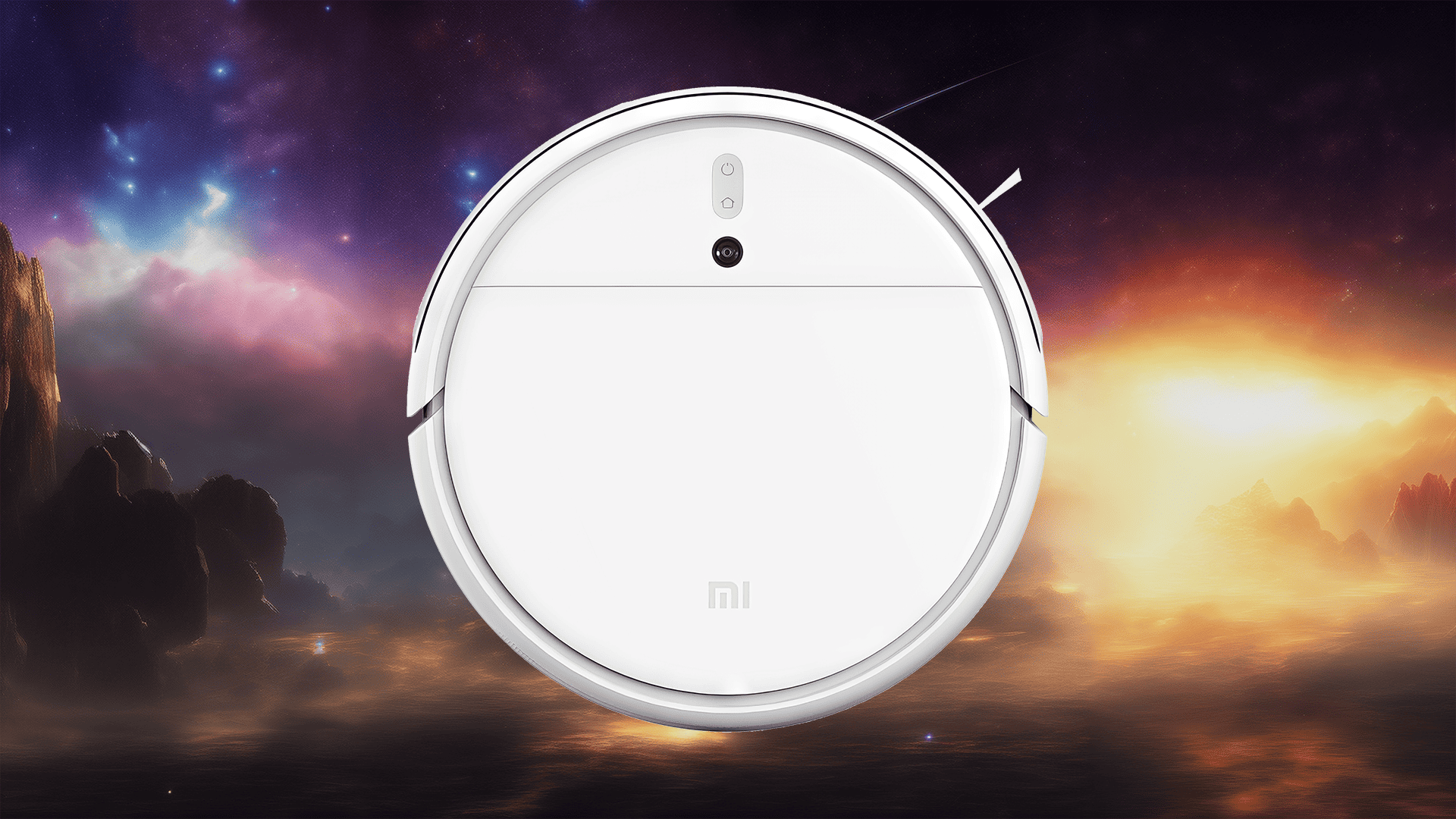

Thanks, Liam! It is a nice review. However, I did not understand how to set up the Xiaomi Mi Robot Vacuum Mop 1C to work with Home Assistant. Could you please teach how? Xiaomi Miio integration does not support it and I did not discover how to integrate it. Thanks.